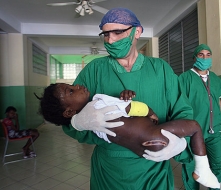
Publicado el sábado 23 de enero del 2010
Médicos cubanos
salvan vidas en Haití
JUAN CARLOS CHAVEZ
  |
Con una pierna fracturada a
punto de infectarse, Keder Chery
no podía darse el lujo de
preocuparse el viernes por el
hecho de que los médicos cubanos
que lo atendían en la clínica La
Renaissance no eran ortopedas
sino oftalmólogos. "Ha sido un hombre afortunado'', comentó Ernesto López, un anestesiólogo. "Muchos haitianos no corren la misma suerte bajo estas condiciones''. Chery, de 50 años, se recuperaba satisfactoriamente. Uno más entre miles de víctimas del terremoto que han pasado por esta clínica en el centro de la capital, cerca de la destruida catedral. Aquí, hasta hace dos semanas, López y otros 30 especialistas cubanos pasaban horas operando de la vista a personas de escasos recursos, en el marco de la Operación Milagro, un programa patrocinado por el gobierno de Cuba. Pero con los principales hospitales de la capital en ruinas o seriamente dañados, la atención oftalmológica ha pasado a un segundo plano. Los cubanos no son la excepción en medio del panorama desolador y las nuevas prioridades que impone la crisis. Médicos de México y Sudáfrica, entre otras nacionalidades, trabajan esforzadamente para salvar la mayor cantidad de vidas sin reparar demasiado en la división de las especialidades. |
"Todos hacemos nuestros mejores
esfuerzos. Se logran grandes cosas
aunque no contamos con las facilidades
que ya quisiéramos tener'', comentó
André Keyser, un paramédico sudafricano,
quien vino con un equipo de emergencia
enviado por su gobierno.
A Keyser no le sobraba el tiempo. En una
sala de emergencias improvisada frente a
La Renaissance atendía a pacientes en
estado crítico, sin contar con sistemas
de monitoreo de corazón ni tanques de
oxígeno. En toda la ciudad han comenzado
a escasear equipos y medicamentos.
El viernes por la mañana, el portavoz
del jefe del Estado Mayor de las Fuerzas
Armadas de Estados Unidos, capitán John
Kirby, subrayó que la prioridad de las
autoridades y los organismos de ayuda es
brindar la asistencia médica oportuna.
Se calcula que el terremoto causó más de
100,000 muertos y dejó heridos a cientos
de miles.
En los alrededores de La Renaissance hay
pequeñas carpas abarrotadas de pacientes
gritando de dolor y con un sol intenso
quemándole las heridas. No muy lejos de
los heridos reposaba el cadáver de un
niño, envuelto en unas sábanas
ensangrentadas.
"Esto es lo peor que le puede pasar a
cualquiera. Cada día aumenta la tensión'',
precisó la doctora cubana Adriana Pomada.
"Hay que ser fuertes y dar lo mejor de
sí''.
La semana pasada, Cuba envió a Puerto
Príncipe al menos 30 enfermeros y
laboratoristas con insumos, bolsas de
suero y plasma, para que se sumaran al
contingente de 344 médicos y paramédicos
que ya trabajan en Haití.
Entre los veteranos de la Operación
Milagro está la internista Olga María
Delgado, que lleva 26 meses. Según ella,
la prestación de servicios de emergencia
podría estar a punto de colapsar y
añadió que hace falta más personal en la
ciudad para evitar que se desate un
brote infeccioso masivo.
Aunque es imposible hacer un cálculo
exacto sobre la cantidad de personas que
han sido atendidas en La Renaissance,
comentó Delgado, "es posible que en la
primera semana después del terremoto se
realizaran más de 1,000 intervenciones''.
Mientras tanto, las emergencias van en
aumento.
A una niña de 2 años debieron amputarle
la pierna después de agotar todas las
posibilidades.
Una joven tuvo que aguantarse el dolor y
soportar un tratamiento de raspado sin
calmantes para desinfectarle una herida.
Otra murió de osteomelitis.
"No importa que parezca imposible'',
subrayó Delgado. "Hay que seguir
luchando''.
http://www.elnuevoherald.com/noticias/ultimas-noticias/story/635265.html